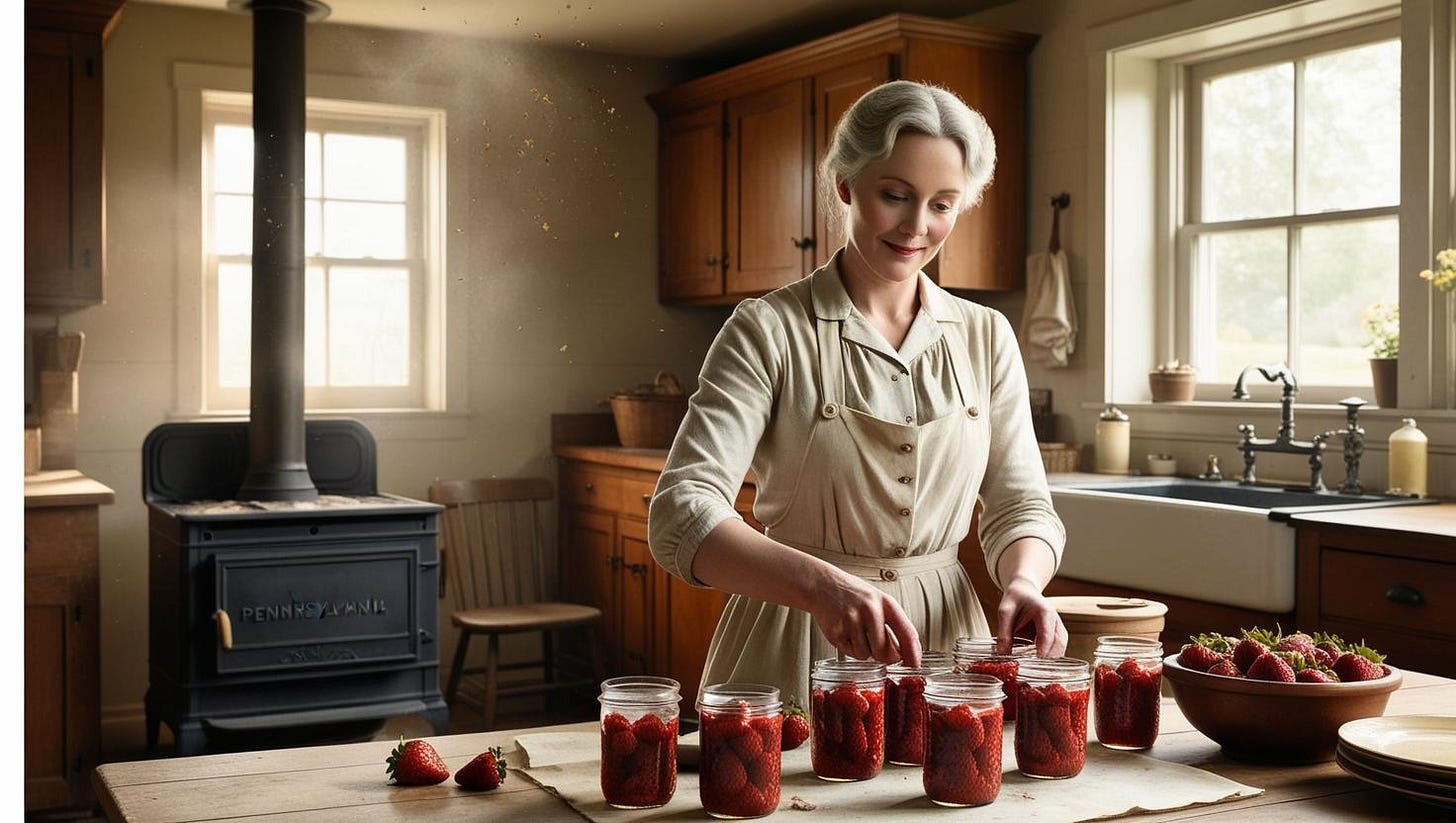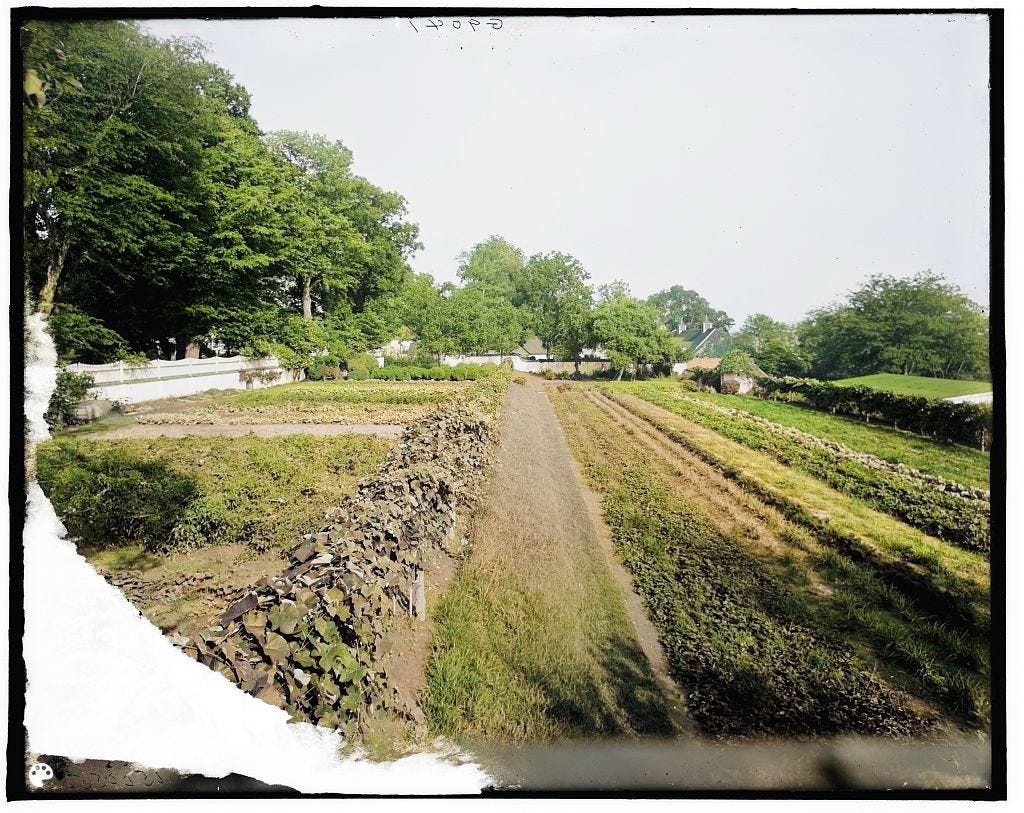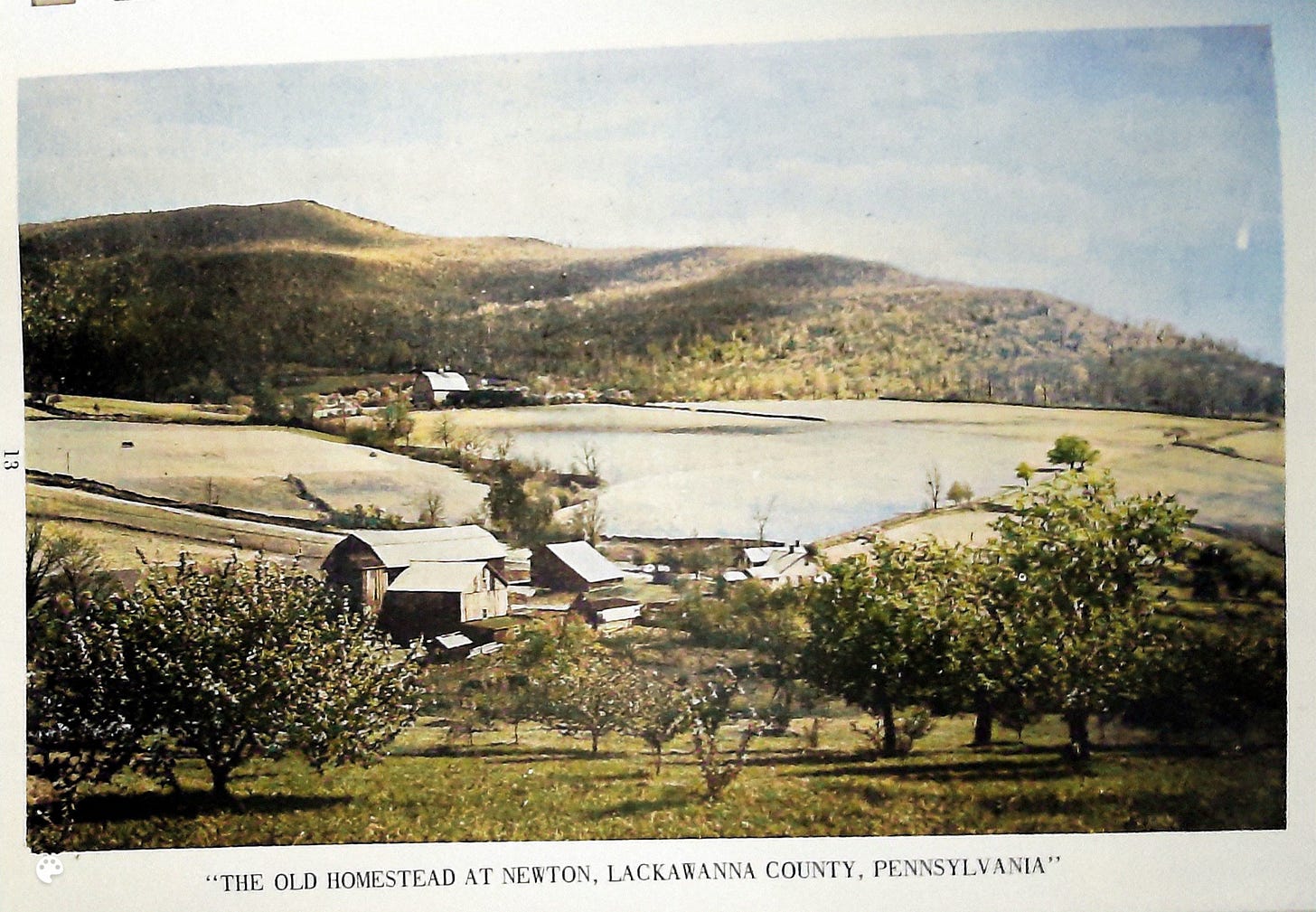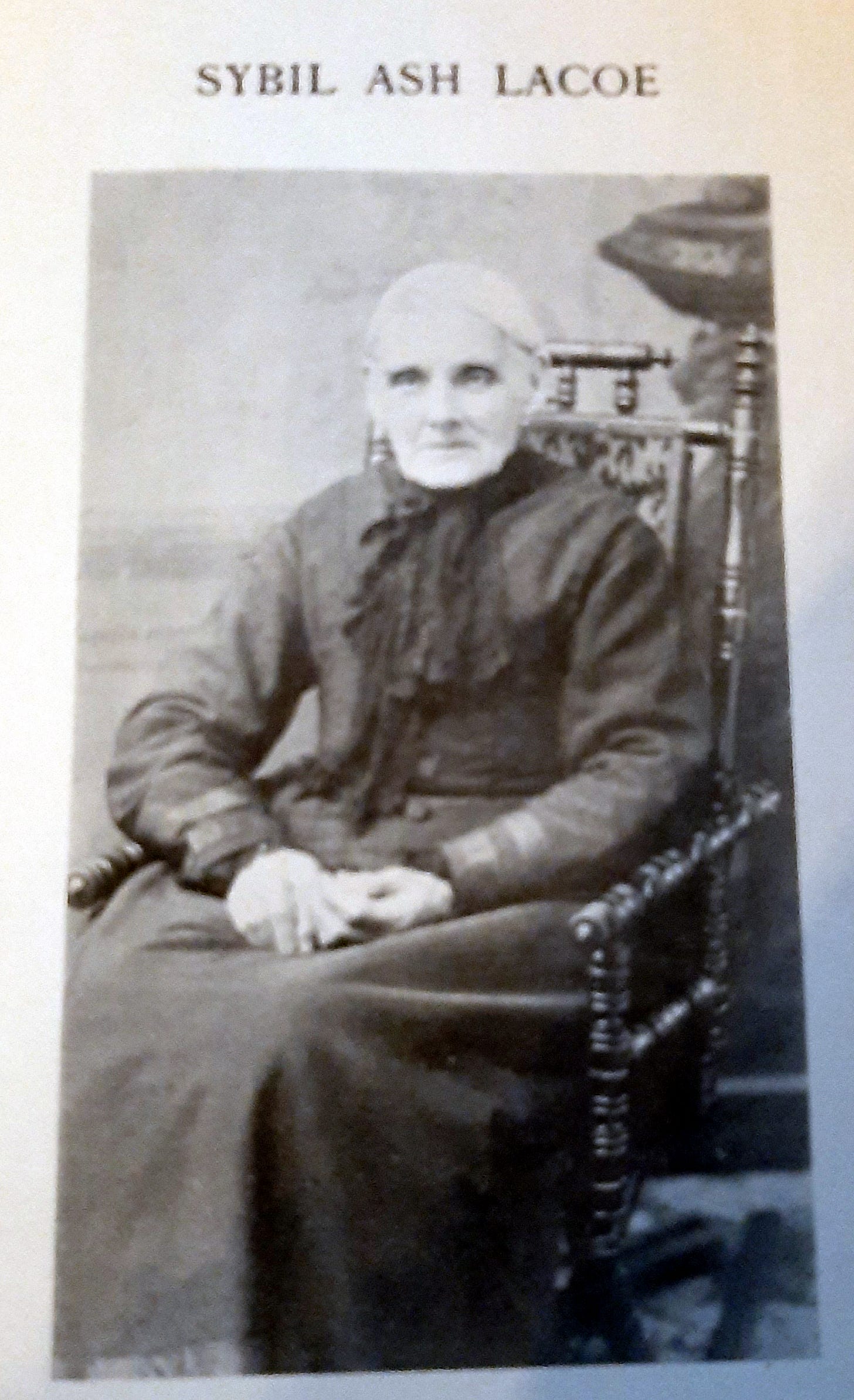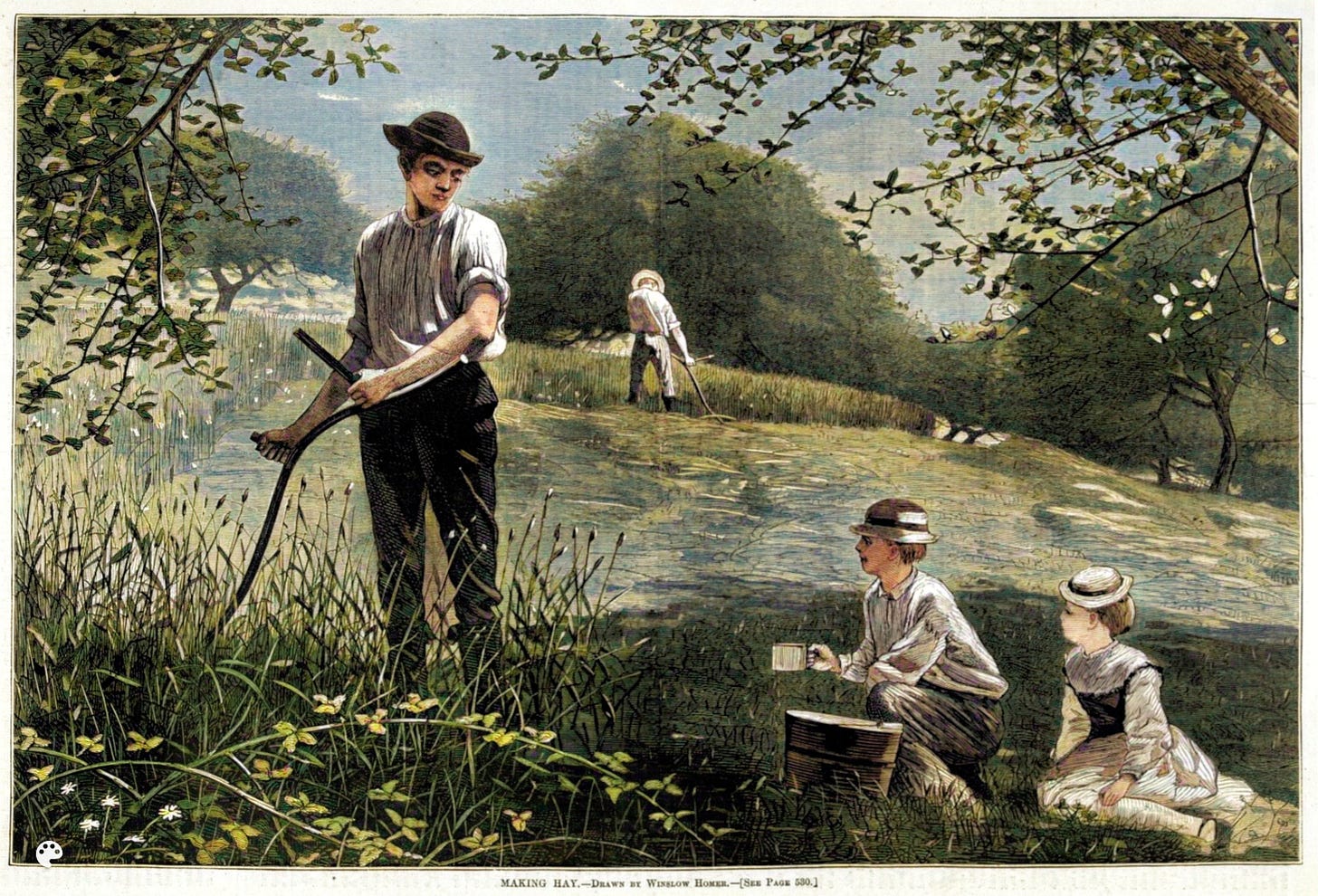HANNAH MARY (DECKER) PETTY (1886-1961) great-grandmother
Ancestral Women 31-Day Challenge - Day 9
Getting a rewrite 10 April 2025
Hannah inspired my mother to be a genealogist. “[Grammie] showed me her copy of The LaCoe Book, which sparked my lifelong interest in family history, and patiently answered my endless questions.” (Her granddaughter to Deborah Carl, 2023. The LaCoe book documents all the descendants of Antoine Desiré LeCoq and the last update was done in 2020, the earliest copy I have is 1943.)
Hannah was a farmer's daughter and grew up to marry a farmer, John Francis Petty (aka Frank Petty), in 1909. He was a tall man of medium build, light brown hair, gray eyes, and probably strong from the physical labor he did every day. The Depression didn’t affect the family very much. They made do with what they had, lived off the farm, and cut back on their meat consumption. Conditions on the farm were probably primitive. In 1934, they still did not have indoor plumbing or electricity, and were still using horses for transportation and farm work.
Education was very important to Hannah. While Frank wanted the boys to help out on the farm, Hannah insisted they finish high school. Because of that education, her twins, Milton and Melvin, were able to take the pilot’s test, and leave the ranks of the infantry in World War II to fly fighter planes. Her youngest son, Norman, enlisted in the Marines. Hannah was blessed that all three of her sons returned home safely.
After the war, Hannah and her husband left the farm. The boys didn’t want to be farmers and Frank couldn’t do it alone. They left Ransom, Lackawanna, Pennsylvania and moved to Baltimore, Maryland. “She not only took care of me and Uncle Norman’s children, but while raising her own six children, she also took care of her father, Andy Decker, who evidently lived with her after his first wife, Grammie’s mother, died, and she took care of Uncle Melvin’s family, particularly his son, Hal, who was severely disabled and died when he was only six years old. She was a born caregiver.” (Her granddaughter to Deborah Carl, 2023.)
Hannah had three daughters, Mary, Florence, and Laura. Florence married a farmer, and Frank and Hannah were living with them in Clarks Summit, Newton, Pennsylvania, when Hannah died of Hodgkin's Disease in 1961 at age 75
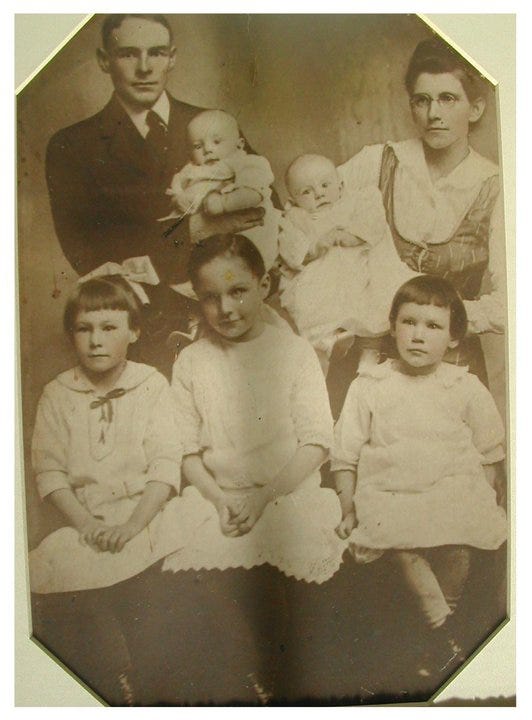
MARY ESTHER (MEAD) DECKER (1860-between 1910 and 1920) 2nd great-grandmotherMary (aka Esther) was born the year before hostilities broke out between the North and the South. She was the third child of John David Mead and Hannah Grace Patrick and a fourth one was born in June 1861, so John probably felt he could not leave his family and farm and volunteer to serve during the American Civil War.
John’s farm in Greenfield Township, Luzerne, Pennsylvania was not doing as well as many of his neighbors so he moved the family to Falls Township, Wyoming, Pennsylvania. This was about six miles from where John Anderson (aka Andy) Decker was working on his father’s farm in Overfield Township, Wyoming, Pennsylvania. Falls and Overfield were small communities. Today, they do not have their own school districts and many of the students are enrolled in Tunkhannock, Wyoming, Pennsylvania. Esther and Andy were about the same age and probably met at school, at church, or at a community social activity.
They married on 11 April 1884 and lived on the property owned by Andy’s father. Andy probably helped his father with the farm and continued to do so until his mother’s death in 1906. Since Andy had eight sisters and two brothers who all lived to adulthood, the farm was probably sold and the proceeds divided among the children, and in the case of one of his sisters who had passed away, her heirs. Andy probably took his share and bought his farm in Newton, Lackawanna, Pennsylvania, which he owned free and clear, but it was not enough to provide for his family so he also worked as a laborer on other farms while his only son, Johnie, worked the family farm full-time. It wasn’t enough, and by 1920, Andy was renting a home in Clarks Summit, Lackawanna, Pennsylvania, and working as a clerk in a lumber warehouse
.
Esther had given birth to five children who all lived to adulthood. She also took in her niece and nephew, Elvira and Willie Mead. These were the two minor children of her brother, William P. Mead and his wife, Barbara Abigail (aka Abbie) (Moran) Mead. They had another daughter who had married before her father’s death, and three more children who had died young. Shortly after Esther’s death, Abbie married Andy.
HANNAH GRACE (PATRICK) MEAD (1831-1910) 3rd great-grandmother
Falls, Wyoming, Pennsylvania was part of the fertile area along the Susquehanna River. Farming was essential to the communities, and the Agricultural College of Pennsylvania was started in 1862 with a mission to “perform investigations in agriculture and communicate this knowledge to the state’s farmers.” (“Pennsylvania Agricultural Cooperative Extension Records,” PennState University Libraries.)
Hannah’s father, Noah Patrick, was doing extremely well on his farm. While his neighbors’ farms were worth between $300 and $5,000, Noah’s farm was worth $10,000 and he had over $2,500 in personal assets. Hannah and her siblings probably wanted for nothing. Noah was also a minister in the Methodist church, and probably taught temperance in his home and expected his children to be good examples to the community.
So John D. Mead, Hannah’s husband, may have felt he was not performing up to the Patrick expectations. First he was five years younger than his wife, and after five years of marriage, his was the poorest farm (worth $400) in his neighborhood (the other farms were worth between $500 and $8,000). Perhaps he was trying to keep up with his neighbors by hiring a household servant, or perhaps Hannah was having trouble keeping up with the children, ages four, three, and five months, and with the household chores.
Hannah was not a sickly woman. She had not grown up with servants living in the home and probably did not employ one after that. In 1880 she had her three-year-old twin grandsons living with her, probably to give her daughter Catherine a break as she had two younger children to also care for. Hannah still had her daughter Esther at home, so there were two adult women in the home to run after the twins.
The days of a farm wife were full. Her husband and teenage sons would work the fields of corn, grain, and hay, the berry fields, the vineyards, and the orchards depending on what their farm was producing. The wife would take care of the washing, ironing, milking, chickens, sewing (which included alterations to make things last), cooking, cleaning, and child care. She probably also had a pig which would consume almost anything organic and would make lovely bacon, hams, chops, and sausage in the fall. Once the children were old enough, they’d be given chores to help out. She also probably had an acre called the kitchen garden where she’d grow the food they would eat fresh, can, dry, or put into cold storage for future meals – probably peas, beans, potatoes, tomatoes, lettuce, carrots, radishes, broccoli, cabbage, squash, etc.
Many farm wives complained of the loneliness, the monotonous drudgery, and the worn and dowdy dresses. Others rejoiced that they could work alongside their husbands and enjoy the fresh air, healthy living, and good food. Hopefully, Hannah was a positive person and brought joy to those around her.
MARY ANN (LACOE) PETTY (1860-1939) 2nd great-grandmother
From the 1943 Lacoe Family Book
She was born on the homestead farm in Newton, Lackawanna, Pennsylvania and “received a common school education, attending the LaCoe school near her home.” In 1880, she married Milton Wagner Petty and moved to the Petty home in Milwaukee, Lackawanna, Pennsylvania.
Mary and Milton had nine children, three of whom died at two years of age.
“Mary Petty was a member of the Milwaukee Methodist Church, Sunday School and Ladies’ Aid Society where she was a faithful worker. She was a member of Echo Valley Rebekah Lodge, No. 339.” (The Rebekah Lodge was the female counterpart of the Odd Fellows – a service organization based on Judeo-Christian ethics.)
At age fifty-six, she broke her hip. She had to use a crutch to get around for the rest of her life, but that did not keep her from her homemaking duties or from traveling and fishing with her husband. “As a respite from farm duties, they spent many week-ends fishing at Promised Land Lake…In 1925 and again in 1931 they spent part of each winter at St. Petersburg, Florida, enjoying the sunny South, fishing in the Gulf of Mexico and visiting places of interest…”
Sybil’s father was a carpenter from Connecticut who settled in Wilkes-Barre, Luzerne, Pennsylvania. He met Mary Miller, a Wilkes-Barre native, and they married in 1816. Their third child, and third daughter, Sybil was born in Wilkes-Barre in 1825.
Wilkes-Barre was known as “The Diamond City” because of the large deposits of anthracite coal. Coal drove the growth of the city. Links were created so boats of coal could travel to the main waterways. The canal between Wilkes-Barre and Pittston was only forty-eight inches deep.
But the family did not stay in Wilkes-Barre. In 1840 they were in Tunkhannock, Wyoming, Pennsylvania, a farming town “on the flood plains where Tunkhannock and Bowman creeks flow into the Susquehanna River.” By the time the Ash family arrived, the town had “several stores, a post office, hotels, churches, mechanics’ shops and numerous residences.” (See Tunkhannock Borough History ) This is probably where Sybil met her husband, William Anthony LaCoe.
While Sybil’s in-laws were baptised in the Catholic Church, Sybil was not. Her parents were married by “Rev. Mr. Lane.” Since her daughter Mary Ann Lacoe and her descendants were active in the Methodist Church, it was likely Sybil was also.
William moved his family to his father’s home in Pittston, but he wanted a farm of his own and he found it in Newton. Sybil was probably taught homemaking skills by her mother, but adjusting from living in a town to being a farmer’s wife might have been challenging. William was a successful farmer. His farm was worth $5,500, and he had $1,000 in personal assets, which was comparable to his neighbors. Life must have been good because all eleven of William and Sybil’s children lived to adulthood. In her older age, they hired a live-in servant to help Sybil with the domestic chores.
SARAH (NAGLE) PETTY (1819-1896) 3rd great-grandmother
Sarah appears in the Portrait and Biographical Record because her great-grandfather, Johann Peter Storbel/Steckel “was of German birth and a member of a very wealthy family that was represented among the pioneers of Pennsylvania.” Other than bragging rights, that probably didn’t have much of an impact on Sarah’s life.
She was the daughter of a well-off farmer living in Hanover, Luzerne, Pennsylvania, where she probably met and married Peter Petty. Peter was a well-off farmer, but he was also an alcoholic.
Sarah and Peter had eight children, the last being a set of twins, Milton and Martha. Upon Peter’s death in 1874, the court named Sarah the guardian of the twins who were still minors. Being named guardian did not mean Sarah had been in danger of losing custody of her children, it meant that she was responsible for the assets the children had inherited from their father’s estate.
Sarah must have been a tough woman because after her husband’s death, she worked the farm. Milton helped, and Sarah probably hired seasonal help. Sarah was not unique, there were other widows in her neighborhood who were listed as farmers.
JENNIE MARY PETTY (1838-1882) 2nd great-grandaunt
Peter Petty’s alcoholism deeply affected his daughter Jennie. She devoted her life to Christianity and Temperance. Two years before her death, she wrote Nora and Mercy’s Angels. She wrote the book, “in part to sound such an alarm in time, to hang the signals of their danger along the path of the unwary, to show the lurking demon that coils in the inebriating cup, and to uncover in some measure the arts of the subtile deceiver, who lures but to betray, that these pages were written.”
The book is very preachy and while there are glimpses into Nora’s life, there really isn’t a story.
Jennie became a teacher and later a lecturer. Jennie never married and continued to live in the family home until her death.
ELIZA DORIS (WILLIAMS) DECKER (1824-1906) 3rd great-grandmother
Her husband, Isaac, could neither read nor write, but Eliza could. Their children attended school and learned to read and write. Isaac came from a family that wasn’t doing well financially. In 1851, about six years after Isaac and Eliza had married, Isaac’s father Charles bought land from Eliza’s father, John C. Williams. He lost the land in 1856, which was sold at “the sheriff’s sale,” and after a lengthy process, Charles and his wife Jane were evicted.
There is no evidence that Isaac ever owned any land. The farm was in Eliza’s name. Her father, John C. Williams, had bought the property in 1860 and deeded it to her in 1869 probably because she and Isaac were struggling to support their twelve children, which included a set of twins born in 1860. The farm was worth about $1,500 and Eliza had $150 in personal assets, much less than most of her neighbors.
At age 82, Eliza cared for her daughter Jane who died of tuberculosis in April of 1906. Eliza died later that year just shy of her 83rd birthday of “varicose ulcers leading to exhaustion.”





